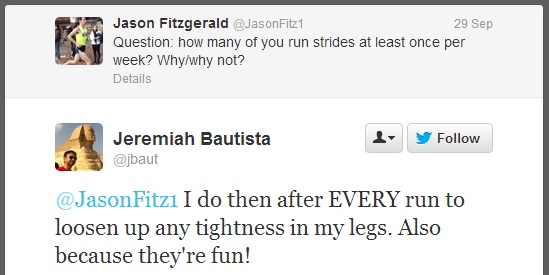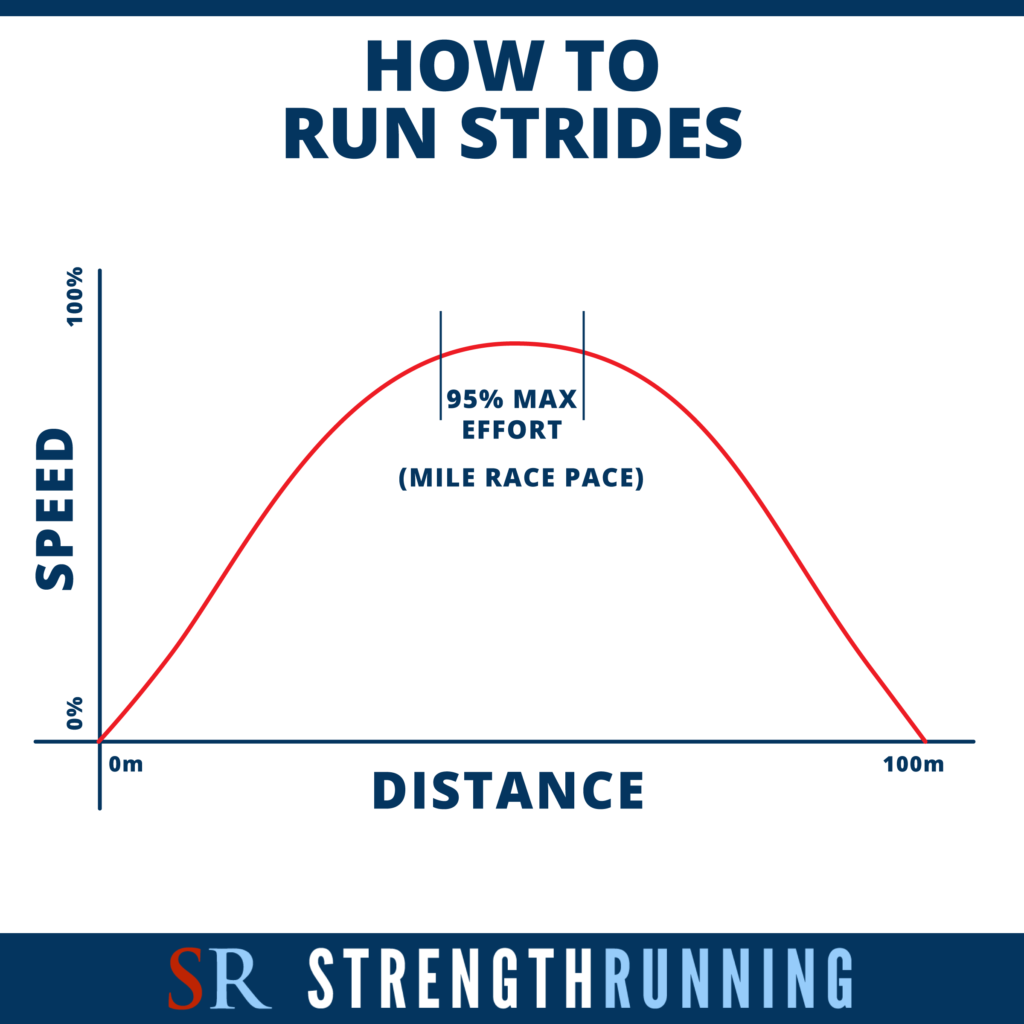What are strides? I get this question ALL THE TIME so I thought it would be helpful to explain exactly what they are and how to use them in your training.
I also surveyed runners on Twitter – you can follow me @JasonFitz1 – to see if they ran strides. I’m glad I’m not the only one who loves them so much!

Strides – or accelerations – are a staple of almost every high school, university, and professional running team. You’ll see middle schoolers and senior citizens running strides! Whether you’re an 800m specialist, cross country runner, or an aspiring marathoner, strides are a fundamental building block of speed and coordination.
But the majority of recreational runners never run strides regularly despite a host of benefits. They’re not sure what they are because they’ve never asked the important question what are strides?
This is fascinating because they only take a few minutes, help you dramatically improve your training, and they can be done anywhere.
So, what exactly are strides?
What are strides?
Strides are also known as striders, stride-outs, or accelerations.
They’re about 100m accelerations where you start at a jog, build to about 95-98% of your max speed, and then gradually slow to a stop. One stride should take you about 20-30 seconds depending on your ability.
You can start with four strides and after 3-4 weeks increase that to six if you’re ambitious (staying with 4 strides is fine, too). Take about 60-90 seconds of walking or standing in between each stride to catch your breath. Running strides is not an aerobic workout so don’t rush them – you get zero additional benefit by shortening the recovery period!
In fact, it’s best to think of strides as a speed development workout. The goal is not aerobic development, endurance, or getting in “a good workout.” This is not for the benefit of your cardiorespiratory system – it’s not a “heavy breathing” workout.
Rather, strides aim to build turnover and comfort at high speeds.
Here’s a video demonstration of how to run strides (so you never have to ask “what are strides” again!):
Keep in mind that strides are very short and you’re only running really fast for a few seconds, so they shouldn’t be too difficult. Fast does not always mean hard.
Here’s another video demonstration of how to run strides. This time, I take the camera with me:
Always remember to stay relaxed during a stride – at no point should you be straining, struggling, or racing.
Where should I be running strides?
You can run them anywhere! I’ve done them in parking lots (be careful…), sidewalks, roads, fields, or on the track. If your yard is big enough you can even do them there.
All you need is a clear place to run that’s about 100 meters in length.
My favorite way to intelligently use barefoot running in a training plan is to incorporate barefoot strides 1-2 times per week. It’s best to do these on a synthetic turf track where the surface is predictable, plush, and free of debris.
If you’re a track athlete or you like racing in spikes or racing flats, strides with your racing shoes can serve as a useful “bridge” between running full-time in training shoes and wearing more aggressive racers for either workouts or races.
Just finish your run, change shoes, and start striding out!
Can I run strides uphill?
Yes! While strides are traditionally run on a flat surface, running them on an incline is a great variation that will help build extra power, strength, and injury resilience.
In this format, you can slightly reduce the speed of a stride but run them for an extra 5-10 seconds. This video demonstration shows me running uphill strides on a dirt path:
For a more in-depth conversation on “mechanical output” (a wonderful byproduct of regularly running strides) and how strides help build this coveted skill, listen to episode 276 of the Strength Running Podcast:
Coach David Roche (the 2024 winner of the Leadville 100 Miler and course record holder) and I discuss how power is built in training, why it’s so valuable for runners, and several different ways to build power as a runner.
When should I run strides?
Strides are best incorporated in two different situations:
- After an easy or base run. In this scenario, think of strides as a dynamic stretch. They help increase your range of motion, work on your turnover, and subtly improve your form. By shaking out some of the tightness you might feel after miles of running at the same pace, strides can help you feel better for your next run. This is particularly beneficial when you run strides the day before a workout or race.
- Before a workout or race. Here, strides prepare your body to run fast. They serve as your transition to sustained, harder running.
In either situation, strides should be run at about the same distance and pace. It’s rare to change how a stride is executed.
But rules are meant to be broken! If you’re preparing for a very short, fast race like a mile on the track or 800m, you may want to do shorter, faster strides. They’ll do a better job of opening up your range of motion, metabolically priming you for running really fast, building power, and getting you comfortable at near maximum speeds.
And the opposite holds true as well: if you’re running a marathon, a few longer, slower strides can help you warm up properly. These can be embedded in a 5-10 minute pre-marathon warm up run.
If you’re not vying for a Boston Qualifying time, just skip the running before the race. It’s too stressful and eats up more energy than is worth it for slower runners. You don’t even have to worry about the question what are strides if you’re racing a marathon.
Why should I be running strides?
This is like answering the question, “Why should I do a long run?” The benefits are so profound that I’m not sure where to start!
But here’s a short list to get you excited about running strides:
- They help you loosen up after a slow distance run (i.e., you’ll just feel better)
- Strides serve as a transition to faster workouts – especially for beginners learning how to start running
- They increase your running economy by reinforcing proper running form (i.e., they make you more efficient)
- When done barefoot, they develop foot and lower leg strength with only a small risk of injury
- They metabolically prepare you to run fast before a race or hard workout
- They only take a few minutes

Most of the runners I coach tell me that they’ve learned to love strides and they make them feel better. Since they’re short, strides don’t require too much effort and they’re actually easy for most people.
Can I run strides on a treadmill?
Of course! Strides are so versatile you can certainly run them on the treadmill.
You’ll need to do them slightly differently than outside, though. Remember these tips for treadmill strides:
- Run them during the last mile of your run instead of after the run
- Increase the pace quickly to simulate accelerating on the road
- Peak at a controlled (but not maximum) sprint for 2-3 seconds and then quickly decrease the pace
- Decrease the pace to 10-30 seconds slower than your easy running pace to recover
- Run easy for about 1-2 minutes before increasing the pace for the next stride
This pattern can be repeated to run 4 or more strides on the treadmill.
Want to learn more about training fundamentals? We’ve created an entire ecourse to help you learn more about how to run properly.
Sign up here and your first lesson will be delivered to you ASAP!